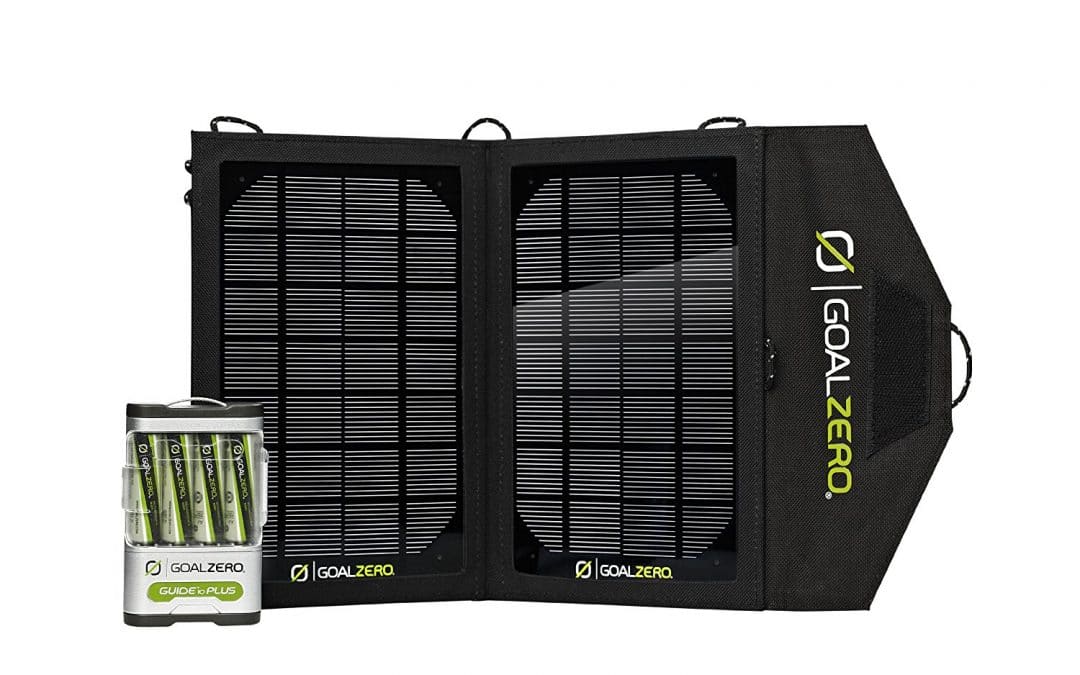If you’re someone who can’t do without your gadgets while in the wild, you need a reliable, portable power source. In this case, you can’t go wrong with a solar recharging kit. Today, we’re going to review the Goal Zero Guide 10 Plus and find out if it’s a good backup charging solution for your outdoor adventure.
Being outdoors means that you have no choice but to give up certain conveniences and amenities that the modern lifestyle affords us. Back in the day, it just used to be you, your equipment, and the vast expanse of nature.
However, times have changed, and technology continues to evolve. In turn, this gave birth to the modern outdoorsman.
These days, it’s common for hikers, campers, backpackers, fishers, and hunters to carry their smartphones, GPS, and other gadgets as they challenge the great outdoors. So it pays to figure out the best way to keep them powered up.
[amazon box=”B00D2SQ6W8, B01IQXDTGY, B01HQNKKDA ” template=”table”]
Shopping for Solar Chargers
You find an overwhelming number of solar charging devices on the market, with a variety of prices and capacities.
Most importantly, choosing the right model depends significantly on how you plan to use it. Consider how often you’ll use it, where you’ll use it, and how much you expect from a solar charger. Balanced with your budget, these factors will weigh heavily.
How you’ll use your solar charger
Consider which devices you’re likely to bring along. If you’re only hoping to keep your phone charged, you’ll find a number of budget-friendly choices. However, if you’re also bringing along a GPS, you’ll need a higher capacity charger.
Connections
Most solar chargers offer USB port charging. Take a look at your existing devices as well as any future purchases before choosing a model. You may need to pick up an adapter to use it with all your electronics gear.
How will you charge?
If you’re planning on hiking, biking, or kayaking, you’ll want a solar panel that you can wear on the go. This is the most convenient way to be sure you have plenty of juice when it’s time to set up camp. But check the weight of any model you’re considering. Also, look for mounting straps for wearing the panel.
Power source
While many solar chargers will power your device directly from sunlight, you may prefer one with an integrated battery. If you think you’ll do most of your charging at night, you’ll want a system with an internal battery to hold the charge collected during the day.
Alternatively, you may want to purchase a power bank. But remember, if you’re on the go, it could become awkward to wear both the panel array and the power bank comfortably.
Goal Zero Guide 10 Plus Review
Goal Zero is a company known for its portable power devices that are designed to power everything from smartphones to a complete mobile home. The Goal Zero Guide 10 Plus is actually one of their smaller and more affordable products.
This solar kit consists of two separate components: the Goal Zero Guide 10 Plus Battery Recharger and the Nomad 7 Solar Panel.
General Specifications
Below are the specifications for the Goal Zero Guide 10 Plus, straight from the company website:
Goal Zero Guide 10 Plus Specs
- Product SKU: 21005
- Chainable: No
- Weight (w/batteries): 6.4 ounces (181 grams)
- Dimensions: 2.5 by 4 by 0.75 inches (6.4 by 10.2 by 1.9 centimeters)
- Operating Usage Temp: 32-104 Fahrenheit (0-40 Celcius)
- Certs: CE, FCC, ROHS
- Warranty: Six months
Nomad 7 Plus Tech Specs
You’ll also want to look over the specs for the Nomad 7 Plus solar collector:
- USB Port: 5 volts, up to 1.4 amps (7 watts max)
- Guide 10 charge port: 2.5mm, 8-9 volts, up to 0.8 amps (7 watts max)
- Rated Power: 7 watts
- Open Circuit Voltage Voc: 8-9 volts
- Cell Type: Monocrystalline
- Weight with Kickstand: 12.8 ounces (363g)
- Weight without Kickstand: 9.2 ounces (260g)
- Unfolded Dimensions: 13 by 8.75 by 0.5 inches
- Folded Dimensions: 6.5 by 8.75 by 0.75 inches
First Impressions of the Goal Zero Guide 10 Plus
Goal Zero products are generally known for good design and construction – the Goal Zero Guide 10 Plus is no exception. The recharger itself sports a clean utilitarian design but still manages to have a rugged build quality. Upon holding it in your hands, you know that this thing can stand up against the harshest environments.
In the looks department, the Goal Zero Guide 10 Plus looks like your traditional battery recharger. But you won’t find any plugs in the unit. What makes the kit unique is that it’s powered by rechargeable AA batteries. The batteries are then recharged by hooking up the chassis to the Nomad 7 Solar Panel. This is what makes the Guide 10 Plus perfect for emergency applications to outdoor adventures.
Operation and Performance
The Goal Zero Guide 10 Plus is a very compact unit at 2.5 by 4 inches and weighing only 0.4 pounds. And that’s when the batteries are loaded. This helps with the portability and packability of the unit.
To use the battery pack, all you need to do is plug your device into it. I’ve tried charging my Samsung Galaxy S8 through the USB port, and it did charge the device just fine. As for the charging speed, it should be about the same as charging your device on a computer. So for every 10 minutes, I get about 10 percent charge, which is pretty good.
Alternatively, you can just charge the AA batteries and use it to power your other gear, like your flashlight, radio, headlamps, etc. There’s also an insert if you wish to charge AAA batteries.
As for the solar panel, I was able to charge the Nomad 7 as long as there’s direct sunlight. The panels can charge the Goal Zero Guide 10 Plus in about three to four hours. On the other hand, charging the Guide 10 Plus on a computer via USB took about 6 hours.
My only complaint is that there’s no way to charge the unit directly to an outlet. However, this is easily solved with a USB adapter.
Pricing
The Goal Zero Guide 10 Plus kit costs between $120 and $130, which includes the Nomad 7 Panel, Guide 10 Plus Recharger, four AA batteries, a 12-volt cigarette adapter, and an AAA insert. If you’re going to break down the price, the panel cost about $80 and the recharger approximately $50.
Personally, I think the price is very reasonable for a reliable way to recharge my devices while on the go. However, there are other comparable products that are much cheaper, such as the Anker 21W Dual USB Solar Charger, which goes for around $60.
Goal Zero Guide 10 Pros and Cons
To break it down, let’s look at the advantages and disadvantages of the Goal Zero Guide 10 and Nomad 7 solar charging kit.
Pros
- Affordable
- Compact
- Light
- Well designed
- Charges both AA and AAA batteries
- Panel charges small devices directly
- Charges faster than advertised under optimal conditions
- Doubles as a power bank
Cons
- Not all devices can charge directly from the panel
- Can’t plug into a wall outlet for a “top-up” charge
- Guide 10 Plus isn’t waterproof
- All four batteries needed to be inserted to charge
What Buyers Think
The majority of consumer reviews for the Goal Zero Guide 10 kit show that most buyers are happy with it. The kit has an average rating from Amazon customers of 4.0 out of 5 stars. Happy owners laud it for its ability to charge batteries for those devices that need them. The product isn’t without flaws, however, as many found it less durable than they’d hoped. This can be a critical flaw when it comes to outdoor gear.
REI customers were somewhat more complimentary, giving the kit a very impressive average rating of 4.4 out of 5 stars. Most were impressed with the panel’s direct charge capability. A few expressed some disappointment that it didn’t work well at all in the shade.
What We Think
The Goal Zero Guide 10 is a great product that has mostly what I need from a portable charging solution. It’s lightweight, versatile, affordable, and easy to use. For personal use, the Goal Zero Guide 10 Plus is an easy recommendation. Otherwise, if you need more power for more intensive uses, there is an REI solar panel that you can use.
The usefulness of this unit will depend on your circumstances. I can’t imagine myself taking this kit during backpacking, but for trips that require more electronics, you can expect this kit to be in my bugout bag.
What do you think of this Goal Zero 10 Plus Review? Would you grab this kit for your next outdoor adventure?
Featured Image: via Amazon
[amazon box=”B00D2SQ6W8, B01IQXDTGY, B01HQNKKDA ” template=”table”]

